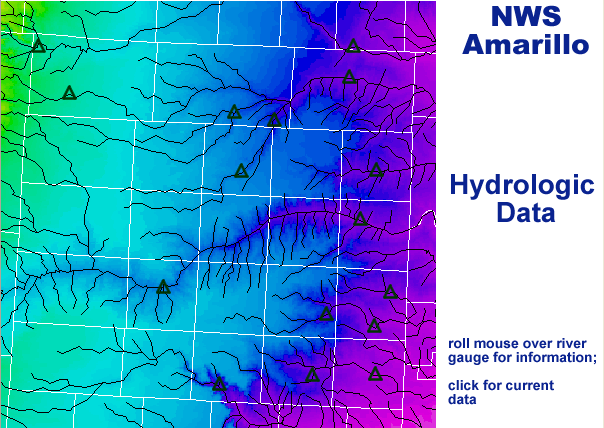
Pacific moisture will continue to bring locally heavy coastal/lower elevation rain and heavy mountain snow to the West Coast and portions of the Intermountain West through Monday. A wintry mix will create hazardous travel across the northern Plains and Upper Midwest into early Monday. Dry, gusty winds are resulting in elevated to critical fire weather in the south/central High Plains. Read More >
 |
|
NWS Amarillo's Hydrologic Responsibility:
|
|
|
|||||||||||||
| Flood Warning | Flash Flood Warning | |
|
|
|||||||||||||
| Flood/Flash Flood Watch | ||||
|
|||||||||||||
| Flood Statement Hydrologic Statement |
Flash Flood Statement | |
|
|||||||||||||
| Hydrologic Outlook (text) Hydrologic Outlook (graphic) |
||
|
|
|||||||||||||
| Hydrologic Summary | River and Lake Summary | |
|
|
|||||||||||||
| ABRFC Significant Flood Outlook USGS National Streamflow Information |
Soil Moisture Data (Palmer drought index, etc.) |
|
|
|
|||||||||||||
|
FLOOD STAGE: The elevation or stage at which overflow of the natural banks of a stream begins to cause damage or begins to present a potential flood-damage hazard in the reach in which the elevation is measured. BANKFULL STAGE: The elevation or stage of the lowest natural banks of a stream or river within the reach in which the water is measured. RIVER GAGE DATUM: The elevation above a chosen datum corresponding to the zero reading of the river gage. FORECAST POINTS: Designated gage sites the River Forecast Center (RFC) uses to make detailed forecasts. These forecasts include current stage, forecast crest, and expected trends. Not all gage sites are forecast sites. FlOOD: The inundation of a normally dry area caused by an increased water level in an established watercourse, such as a river or stream, or drainage ditch or ponding of water at or near the point where rain fell. FLASH FLOOD: A flood which is caused by heavy or excessive rain in a short period of time, generally less than six hours. Also, at times a dam failure can cause a flash flood, depending on the type of demand time period during which the break occurs. URBAN & SMALL STREAM FLOODING: Flooding of small streams, streets and low lying areas, such as railroad underpasses and urban storm drains. This type of flooding is mainly an inconvience and is generally not life threatenting nor is it significantly damaging to property. |
|
|
|
|||||||||||||
